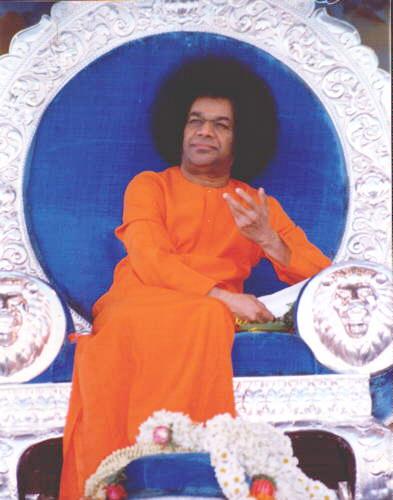March 2002, Prasanthi Nilayam


Prelude:
Shri Sathya Sai Baba's hand-gestures and finger movements, whose real meaning and significance are not easy to fathom, are essentially seven fold. These thoughts on His mudhras were jotted down on the afternoon of Mahaa Maaghi (the holy full-moon day in the month of Maagha) when Baba was graciously distributing apples in the Mandhir in Prashanthi Nilayam.
Shree Raama, the Maayaa Maanusha Avathaar, is called Kodhanda Paani. Bhagavaan Raama had His Divine bow to remove obstacles for the welfare of the Universe and the devotees. Shree Krishna, the Leelaavathaar, is described as Chakra Paani. Lord Krishna was adorned with the Sudarshana Chakra that protects Dharma and provides Aanandam (happiness) to the devotees. The most modern Avathaar of Sathya Sai, the Vibhuuthi Avathaar, is expressing His Divine Powers with a number of Hasta Mudhras (hand-gestures) for the removal of negative qualities from the devotees and transforming them. This Sathya Sai Avathaar can be rightly termed as Saptha Mudhra Paani.
No one can fully understand the innumerable mudhras of Svaami. There are separate meanings for every small gesture according to the time (kaala), context (sandarbha) and situations (paristhithi). However, the Divine gestures are simplistically categorised into seven distinct holy groups to satisfy a number of queries of the devotees. The supreme authority for the elucidation of the meaning of the gestures is the almighty Svaami Himself.
Seven Hasta Mudhras (hand-gestures) of Sri Sathya Sai Baba
1. First is the Abhaya Mudhra. It is the gesture of the raised right hand allaying fear and assuring protection to the devotees.
2. Second is the Varadha Mudhra. It is the downward pointed right palm bestowing gifts and boons to the devotees.
3. Third is the Anugraha Mudhra. It is the gesture of raising both hands indicating blessings for the progress and welfare of the mass of devotees. It may also be called 'Yoga Kshema Mudhra'.
4. Fourth is the Srujana Mudhra. It is the gesture of the circular waving of the right palm pointed downwards for materialising spiritually charged articles (e.g. sacred ash).
5. Fifth is the Thirodhana Mudhra. It is the gesture of circling the right palm in an outward direction driving away impurities or negativity in the surroundings. Alternatively, it may imply the dematerialization of articles created.
6. Sixth is the Shakthipaatha Mudhra. It is the gesture of placing the right palm on top of the head of a devotee for the descent or activation of his spiritual energy.
7. Seventh is the Tharjani Mudhra. It is the gesture of writing in the air with the index finger, or holding up the hand with fingers extended. This may indicate communication with extra terrestrial forces.
Postlude:
The significance of these mudhras is that they are for the welfare of the devotees. The descent of an Avathaar is always for the enhancement of the spiritual life of people and for the promotion of the practice of Dharma (right conduct).
Bhagavaan Sri Sathya Sai Baba has assured all that He is constantly observing us and is available at every step (Sambhavaami padhe padhe) if we sincerely pray from the bottom of our hearts. Let us attempt to understand the hasta-mudhras of Svaami and follow the right path with His divine blessing at every step.
Om Sai Ram!